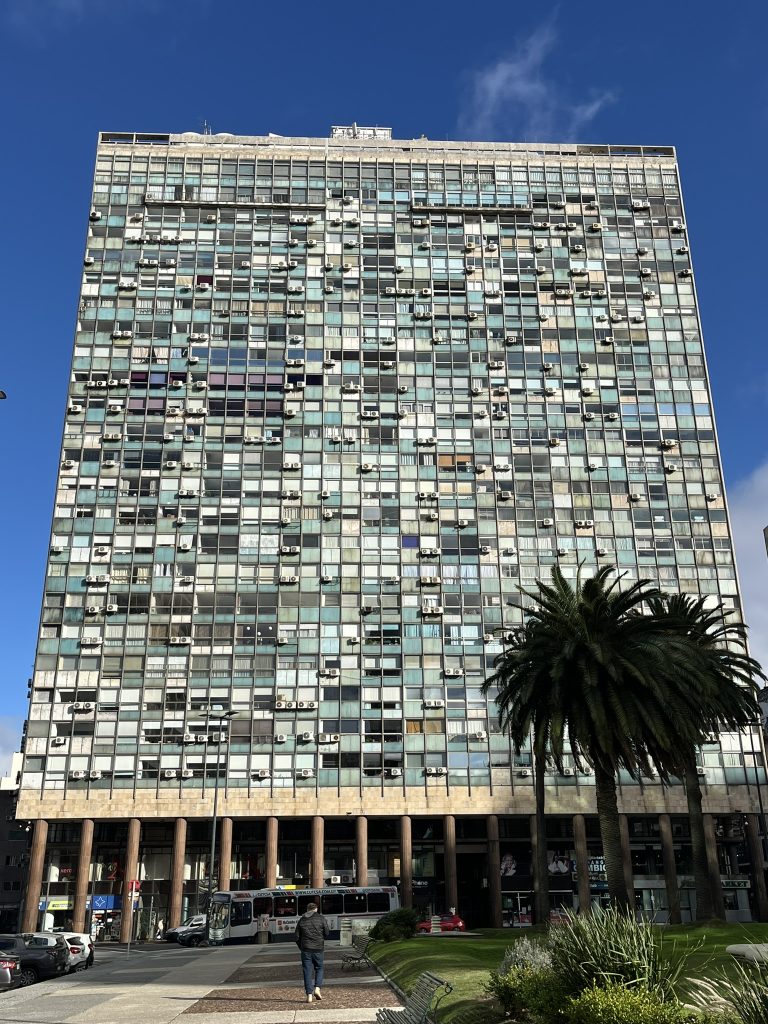After spending five days in Paraguay, I took a short regional flight to the capital of Uruguay, Montevideo. I’ve read different theories about the origin of the name Montevideo, and they all seem plausible. I prefer the version told by my walking tour guide: it is a shortened form of a longer name used by early mapmakers, “Monte VI De Este a Oeste.” The Roman numeral VI denotes the sixth hill along the coast.
I knew little about Uruguay before this trip, except for two events: it hosted and won the first-ever FIFA World Cup in 1930, and the tragic plane crash involving a Uruguayan rugby team in 1972. This tragedy was recounted in the 1993 movie Alive, depicting the impossible situation faced by the 16 survivors battling 72 days of sub-zero temperatures in the Andes.
Uruguay is the second smallest country in South America, with a population of 3.5 million people and 12 million head of cattle. Despite the common conception that South American countries are relatively conservative, Uruguay is rather progressive. For example, according to Wikipedia, it was the first country in the world to fully legalize the growth, use, and sale of marijuana in 2013.
Modern-day Uruguay enjoys a relatively high standard of living. In fact, prices are several times higher than those in its neighbor, Argentina. I spent several days wandering around the old town, taking a walking tour, visiting bookstores, and enjoying more beef.
When it came to ordering food, since I speak no Spanish, I had to rely on Google Translate and some hand-waving. For some reason, I had a couple of mishaps in Montevideo. At Pizzería DOS36, a neighborhood restaurant where many of the customers seemed very familiar with the staff, I thought I ordered the pizza de marisco (seafood pizza) but I received the plato de marisco (seafood platter for two) instead. The following morning, after my latte, I still wanted something to wash down the meal from the previous night, so I ordered a glass of limonada. A few minutes later, a young woman delivered a lemon square to my table.
I had a simple but delicious breakfast at Cafe La Farmacia (formerly a pharmacy) and a couple of meals at two different bookstores, which offered a wonderful atmosphere to nourish my stomach.
When I visit a new city, I enjoy checking out its bookstores. To my pleasant surprise, Montevideo has a vibrant book scene. The two that stood out were Escaramuza and Libreria Puro Verso.
Escaramuza is a couple of kilometers away from my hotel, housed in a grand old house built in 1903. The bookstore is beautiful, with several small rooms lined with really tall floor-to-ceiling bookshelves and display tables. At the rear of the building is a small bakery. In the courtyard at the back of the building is a cozy, tree-shaded cafe with about a dozen tables. On the evening of my visit, it was a Monday, but there was a good crowd in both the bookstore and the cafe. People were chatting, browsing books, and admiring some old photographs on the walls. Two staff members at the cashier were busy serving a steady stream of customers. The cafe was fully booked, and I had to return 20 minutes later to get a table. I ordered the national dish of Uruguay: chivito. It is a sandwich stacked with churrasco (sliced beef), ham, mozzarella, tomatoes, mayonnaise, and black or green olives.
Libreria Puro Verso is located in a pedestrian-only part of the old town district (Ciudad Vieja), a few minutes’ walk east of Plaza Independencia. The store has two levels and a mezzanine. The building is not as grand as Escaramuza, but it has a stunning curved stairway. My walking-tour guide told me the cafe on the second floor is very popular among vegetarians because there are so few of them. That reminded me of when I once asked a waiter in Buenos Aires what vegetarians ordered. He replied with a straight face: chicken. I ordered a strong latte that was excellent, but the vegetarian breakfast was forgettable. Before I left the store, I picked up a copy of Le Petit Prince for one of my sisters to add to her collection of the same title in various languages, many of which I had purchased in different countries.
Colonia del Sacramento: After spending three full days and nights in Montevideo, I took a regional bus to Colonia del Sacramento, about 180 km north. It is a very popular tourist spot, especially during the daytime when crowds of day-trippers come from Buenos Aires across the Uruguay River. The trip is only about an hour long. Historically, due to its strategic location, the town was fought over between the Spanish and the Portuguese and was even under British rule for several years.
While I was there, I joined a Spanish walking tour because there was no English one available. In addition to the guide and me, there was only one other person. With my Google Translate in hand, we strolled through the charming streets of the Barrio Histórico, a UNESCO World Heritage site known for its colonial architecture and the famous lighthouse.
Before dinner, I joined a small crowd to watch the sunset. I had heard that a local custom is to clap after the sun has set. Sure enough, I heard some clapping at the right moment.
Additional Photos















